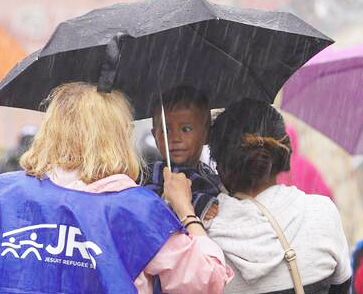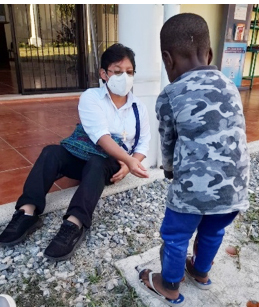
A demonstrator outside a U.S. Customs and Border Protection building in Brownsville, Texas, wears a necklace that reads “END MPP,” to protest against Migrant Protection Protocols Jan. 12, 2020. (CNS photo/Go Nakamura, Reuters)
~ by Rhina Guidos, Catholic News Service
WASHINGTON (CNS) — The justices on the country’s highest court have agreed to hear a case that could decide the fate of a Trump-era immigration policy that Biden administration officials have been trying to end. On February 18, the U.S. Supreme Court said it would hear arguments on whether the Biden administration can put an end to the Migrant Protection Protocols, or MPP, a policy that demands asylum-seekers to the U.S. to stay in Mexico until their cases can be heard in the U.S. immigration courts.
The policy has been a headache for the administration as President Joe Biden promised to end it, but, it proved much more difficult to do so once he took office. As soon as he became president in January 2021, Biden paused the policy, the formally sought to end it a few months later in June.
But in August of that year, a judge with the U.S. District Court for the Northern District of Texas told administration officials that they had to continue complying with the policy, saying they had not ended it properly.
The Supreme Court refused a Biden administration request to block that District Court ruling while the government pursued an appeal with the New Orleans-based 5th U. S. Circuit Court of Appeals. In December, the appeals court upheld the lower court ruling.
Subsequent attempts at ending the policy have failed and it looks as if the high court will be the ultimate arbiter when it hears oral arguments of the case Biden v. Texas, in April.
Immigration supporters, including many Catholic organizations, have railed against the Biden administration for not keeping its word on ending the policy, also called “Remain in Mexico.”
In December, just before Biden administration officials restarted the program, a large group of women religious and their supporters demonstrated outside the White House, shouting just a few feet away from the president’s residence to end the policy.
MPP was put in place in earnest in 2019 under the Trump administration. Opponents of the policy say migrants have been put in danger or killed by being forced to stay in dangerous border towns, as well as in unsafe living conditions as they wait for hearing. Biden administration officials said they had made some improvements to MPP, but many advocates for immigrants weren’t convinced.
The head of the U.S. Conference of Catholic Bishops’ migration committee, Auxiliary Bishop Mario Dorsonville of Washington, said in December that the better way forward was to end it altogether.
The justices could hand down a decision sometime in June or July before summer recess.
To read the entire article please click here

 ~ J.D. Long-Garcia, AMERICA Magazine
~ J.D. Long-Garcia, AMERICA Magazine Jesuit Network with Migrants (RJM)
Jesuit Network with Migrants (RJM) We are thrilled to announce the Cabrini Asylum Seeker and Refugee Hub in Malvern, Australia has won the Victorian Multicultural Commission Awards for Excellence in the Health category.
We are thrilled to announce the Cabrini Asylum Seeker and Refugee Hub in Malvern, Australia has won the Victorian Multicultural Commission Awards for Excellence in the Health category.
 The deaths of the 27 migrants in the English Channel have shocked both Britain and France. Still, shipwrecks of that scale are not uncommon further south in the Mediterranean Sea as migrants flee poverty, natural disasters and authoritarian regimes for a better life in Europe. UN officials estimate that as many as 1,600 people have died or are missing in the Mediterranean this year alone.
The deaths of the 27 migrants in the English Channel have shocked both Britain and France. Still, shipwrecks of that scale are not uncommon further south in the Mediterranean Sea as migrants flee poverty, natural disasters and authoritarian regimes for a better life in Europe. UN officials estimate that as many as 1,600 people have died or are missing in the Mediterranean this year alone.
 spoke on October 5 as head of the Vatican delegation to the executive committee of the U.N. High Commissioner’s Program for Refugees in Geneva.
spoke on October 5 as head of the Vatican delegation to the executive committee of the U.N. High Commissioner’s Program for Refugees in Geneva.
 Church has been celebrating the World Day of Migrants and Refugees (WDMR) since 1914. It is always an occasion to express concern for different vulnerable people on the move; to pray for them as they face many challenges; and to increase awareness about the opportunities that migration offers.
Church has been celebrating the World Day of Migrants and Refugees (WDMR) since 1914. It is always an occasion to express concern for different vulnerable people on the move; to pray for them as they face many challenges; and to increase awareness about the opportunities that migration offers.